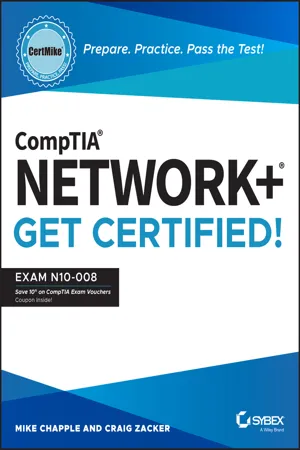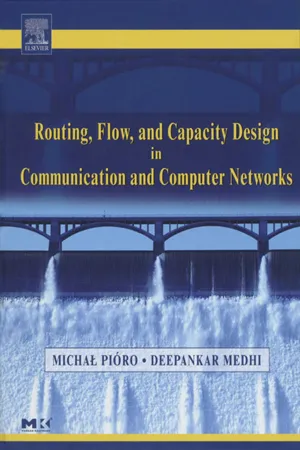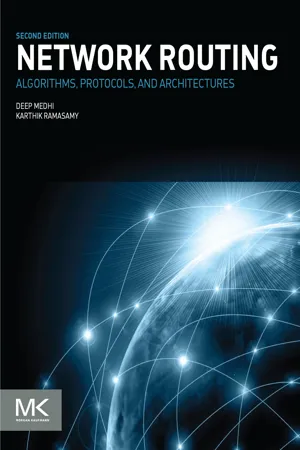Computer Science
Open Shortest Path First
Open Shortest Path First (OSPF) is a routing protocol used to determine the best path for data to travel across a network. It uses a link-state routing (LSR) algorithm to calculate the shortest path between two points, taking into account factors such as network congestion and link speed. OSPF is commonly used in large enterprise networks.
Written by Perlego with AI-assistance
Related key terms
11 Key excerpts on "Open Shortest Path First"
- Glen D. Singh(Author)
- 2020(Publication Date)
- Packt Publishing(Publisher)
CCNP ) Enterprise certification level. However, it's worth mentioning in this section.A loop-free path is one that does not have a layer 3 routing loop on a network. This is very useful in the event a route is unavailable as EIGRP can almost immediately insert the backup loop-free path within the routing table to ensure connectivity.Open Shortest Path First
One of the most popular link-state routing protocols is Open Shortest Path First version 2 (OSPFv2 ). Defined by RFC 1247, OSPFv2 was introduced to the networking industry back in 1991 and since then, it has been widely adopted and implemented in many organizations.The following are the benefits of using OSPF:- Open source : Being open source allows an organization with mixed vendor equipment to implement OSPF to exchange routing information between the various manufacturers of routers.
- Scalability : OSPF can be implemented in a network of any size. Additionally, OSPF can be configured in a hierarchical system where OSPF-enabled routers can be grouped into areas.
- Secure : The OSPF routing protocol supports both Message Digest 5 (MD5 ) and Secure Hashing Algorithm (SHA ) for authentication. This allows two OSPF-enabled routers to authenticate with each other before exchanging OSPF routing details such as network information.
- Efficiency : Unlike older dynamic routing protocols, OSPF will only send an update if a change occurs on a network rather than sending periodic updates at specific intervals.
- Classless : The OSPF routing protocol supports the use of custom subnet masks and VLSM.
- Adjacency table : Before OSPF exchanges routing information with a neighbor router on the network, they both need to establish an OSPF adjacency with each other. This adjacency is simply like a mutual handshake indicating that both are willing to share network routes. This adjacency table contains a list of all the neighbor routers that have established an adjacency with a local router. This table is sometimes referred to as the neighbor table . The show ip ospf neighbor
- eBook - ePub
CCNA Certification Study Guide
Volume 2 Exam 200-301
- Todd Lammle(Author)
- 2020(Publication Date)
- Sybex(Publisher)
CHAPTER 6 Open Shortest Path First (OSPF)The following CCNA exam topics are covered in this chapter:3.0 IP Connectivity-
3.4 Configure and verify single area OSPFv2
- 3.4.a Neighbor adjacencies
- 3.4.b Point-to-point
- 3.4.c Broadcast (DR/BDR selection)
- 3.4.d Router ID
Open Shortest Path First (OSPF) is by far the most popular and important routing protocol in use today—so important, I’m devoting an entire chapter to it! Sticking with the same approach we’ve taken throughout this book, we’ll begin with the basics by completely familiarizing you with key OSPF terminology. Once we’ve covered that thoroughly, I’ll guide you through OSPF’s internal operation and then move on to tell you all about OSPF’s many advantages over RIP.This chapter isn’t just going to be chock full of vitally important information, it’s also going to be really exciting because together, we’ll explore some critical factors and issues innate to implementing OSPF. I’ll walk you through exactly how to implement single-area OSPF in a variety of networking environments and then demonstrate some great techniques you’ll need to verify that everything is configured correctly and running smoothly.To find your included bonus material, as well as Todd Lammle videos, practice questions & hands-on labs, please see www.lammle.com/ccnaOpen Shortest Path First (OSPF) Basics
Open Shortest Path Firstis an open standard routing protocol that’s been implemented by a wide variety of network vendors, including Cisco. And it’s that open standard characteristic that’s the key to OSPF’s flexibility and popularity.Most people opt for OSPF, which works by using the Dijkstra algorithm to initially construct a shortest path tree and follows that by populating the routing table with the resulting best paths. EIGRP’s convergence time may be blindingly fast, but OSPF isn’t that far behind, and its quick convergence is another reason it’s a favorite. Another two great advantages OSPF offers are that it supports multiple, equal-cost routes to the same destination, and like EIGRP, it also supports both IPv4 and IPv6 routed protocols. - eBook - ePub
- Mike Chapple, Craig Zacker(Authors)
- 2023(Publication Date)
- Sybex(Publisher)
Distance vectoring is not a terribly precise way to measure the proximity of a router. A single hop could be a local area network (LAN) connection running at 1,000 Mbps, or it could be a much slower wide area network (WAN) connection. This is why many of the other routing protocols use alternative measurements to calculate their metric values.Open Shortest Path First (OSPF) is an open standard link state routing protocol. Unlike distance vector protocols, link state protocols gather information about the network by transmitting messages called link state advertisements (LSAs) to other routers in multicast messages. Using the information in the LSAs, the routers create a neighbor table and a topology table, essentially a map of the entire network. The routers then use that information to build their routing tables.Unlike distance vector protocols, link state protocols use various criteria to calculate the efficiency of routes through the network. In addition to hop counts, OSPF factors in the transmission speeds of the various network links, the current levels of traffic congestion on the various routes, and a route cost specified by an administrator. The routers then use the Dijkstra algorithm to calculate the relative efficiency of routes to a given destination. OSPF routing tables support multiple routes to the same destination with the same metric and administrative distance values. When this occurs, the router balances the outgoing traffic among the duplicate routes.Unlike RIP, OSPF does not transmit its entire routing table at regular intervals. Instead, it generates updates containing only the data that has changed, which conserves bandwidth and speeds up convergence. OSPF also does not have a hop count limit, as RIP does. OSPF has many advantages over RIP, including route efficiency and convergence speed, but it also requires more processing power, memory, and storage from the router.Enhanced Interior Gateway Routing Protocol (EIGRP)
The Enhanced Interior Gateway Routing Protocol (EIGRP) is an updated version of the earlier Interior Gateway Routing Protocol (IGRP). Although ostensibly a distance vector protocol, EIGRP is sometimes referred to as a hybrid routing protocol - eBook - ePub
Network Routing
Fundamentals, Applications, and Emerging Technologies
- Sudip Misra, Sumit Goswami(Authors)
- 2017(Publication Date)
- Wiley(Publisher)
Best‐effort routing attempts to provide the best feasible path from source to destination without guarantee of any assured level of service. Although a best‐effort routing does not fulfill QoS requirements, it can be modified to satisfy minimum constraints to cater effectively for the assured level of service. On the Internet, which follows best‐effort routing, a single best path towards the destination is computed by each intermediate routing node [35]. The selected path changes with change in the network topology or congestion in any part of the network. As the path is selected and the packets are delivered on a hop‐by‐hop basis, the packets may reach out of order of delivery and may even get dropped in any of the intermediate routers owing to load condition and unavailability of buffer space. Unlike the single‐best‐path selection strategy used on the Internet, best‐effort QoS in a network requires multiple paths to a destination to support various levels of performance. The routing requires a path selection algorithm that efficiently computes a set of best‐effort paths, and forwards the traffic over multiple paths to the destination. However, routing over multiple paths faces the challenge of loop detection and avoidance. Moreover, the best set of paths have to be recomputed if there are changes in topology, including node or link failures.Load‐sharing routing (LSR) [36] is one of the algorithms proposed for best‐effort QoS routing. This algorithm tries to improve the QoS only in those regions of the network where it has deteriorated owing to congestion. The overhead of the routing algorithm is reduced by making only the neighboring nodes of a congested node implement the LSR algorithm. In this routing algorithm, each routing node maintains an active routing table and a passive routing table. The active routing table is created from the node’s awareness of the network topology and gives the shortest path based on Dijkstra’s algorithm from the node to any other node in the network. These paths are referred to as OSPF paths in this protocol. The passive routing table keeps the shortest distance to all other nodes from each of its neighboring nodes as the source node. This is also calculated using Dikstra’a algorithm by keeping the neighbor as the source node. The entry in the routing table comprises the destination node, the next‐hop node, the total cost, the hop count, the OSPF next hop, and the LSR flag. When the LSR flag is false, the node forwards the packet as per the OSPF algorithm and the next‐hop node and the OSPF next‐hop node are the same. When the LSR flag is true, the next‐hop node is calculated on the basis of the LSR algorithm. The algorithm uses a number of different messages to calculate the path. The working of the algorithm can be well understood by referring to these messages. - eBook - ePub
CCNA Routing and Switching 200-125 Certification Guide
The ultimate solution for passing the CCNA certification and boosting your networking career
- Lazaro (Laz) Diaz(Author)
- 2018(Publication Date)
- Packt Publishing(Publisher)
The World of Open Shortest Path First (OSPF)
The OSPF interior routing protocol is a very popular protocol in enterprise networks. This chapter will present a brief history of OSPF and provide a comparison with the IS-IS routing protocol, since this is also a link state routing protocol.We will be learning the basics of OSPF, its features and configuration, and much more. We will be creating multiple labs, since OSPF has different aspects that we need to learn for the certification and the real world. Not only will we be looking at single-area OSPF, but also multi-area OSPF.The following topics will be covered in this chapter:- History of OSPF
- SPF tree calculation
- OSPF metrics
- Configuring OSPF
- Wildcard calculations
- Configuring OSPF in our network
- OSPF DR and BDR
- Verifying OSPF
- OSPF scalability
- Categories of multi-area components
- OSPF router roles
- Types of LSAs
- OSPF Hello protocol
- Neighbor states
- Basic multi-area configuration
Passage contains an image
Brief history
The origins of OSPF date back to the late 1980s by the IETF. OSPFv1 was published in 1989 and OSPF was published in 1991. OSPFv3 for IPv6 was first published in 1997, and a later revision came out in 1999. For the RFC aficionados, RFC2740 was really the one that introduced OSPFv3 for IPv6 in 1999, but it was replaced by RFC5340 in 2008.So, OSPF has been around for a long time and even the IPv6 version of it has been around for ten years, although we still have not fully embraced it.There is another link state protocol that I will briefly touch upon, which is IS-IS. This protocol has be around since the late 1970s but not until 2008 was RFC5308 ready to go for IPv6. This is still a long time and very little has been spoken about it. - Michal Pioro, Deep Medhi(Authors)
- 2004(Publication Date)
- Morgan Kaufmann(Publisher)
CHAPTER 7Networks With Shortest-Path Routing
Shortest-path routing algorithms have existed since two independent seminal works by Bellman [Bel58 ] and Ford [FF62 ], and Dijkstra [Dij59 ] in 1950’s. The difference between these two algorithms is the way information needed for computing the shortest-path is used. In the context of packet-switched networks and Internet routing, in particular, Bellman-Ford’s algorithm has enabled the development of distance-vector routing protocols while Dijkstra’s algorithm has paved the way to the introduction of link-state routing protocols [Hui00 ]. In this chapter, we focus on network design problems (NDPs) related to the latter type of routing protocols since they have gained popularity due to deployment of open shortest-path first (OSPF) [Moy98b ]) and intermediate system to intermediate system (IS-IS) [Cal90 ], [ISO90 ], [Ora90 ])—the most common Internet intra-domain routing protocols.The shortest-path routing principle in packet networks is attractive because it solves the immanent trade-off between routing implementation complexity and traffic effectiveness. The main advantage of shortest-path routing is that it can be implemented in a distributed way, not losing too much out of the traffic effectiveness achievable with more complicated routing strategies. The idea is to assign a cost metric (weight) to each link in the network, and to route packets incoming to a node using the shortest-path to the packet destination where the path cost (length) is computed using this cost metric. Nodes are aware of the current metrics used for the links, and compute shortest-paths to other destinations, storing in their routing tables the next hop for each destination. When for some reason the metrics in the system are changed (for instance, when a link fails, then it is assigned an infinite weight), nodes are informed about the changes in a distributed manner through a protocol mechanism where the originator (e.g., the node to which a failed link is connected) generates the link metric (and other information about the link), called link-state- eBook - ePub
- Oliver C. Ibe(Author)
- 2017(Publication Date)
- Wiley(Publisher)
- RIP cannot handle variable length subnet masks (VLSM). All subnets must have the same subnet mask length.
- Periodic broadcasting of the full routing table consumes a large amount of bandwidth, which is a major problem with large networks especially on slow links and WAN clouds.
- RIP converges slowly. This means that we may not finish running one round of updates before it is time for the next one. Thus, it takes a long time to get a complete update using the algorithm.
- RIP has no concept of network delays and link costs; routing decisions are based on hop counts. The path with the lowest hop count to the destination is always preferred even if the longer path has a better aggregate link bandwidth and smaller delays.
- RIP networks are flat networks; there is no concept of areas or boundaries.
Some enhancements were introduced in a new version of RIP called RIP2 to address the issues of VLSM, authentication, and multicast routing updates. However, RIP2 is not a big improvement over RIP (now called RIP1) because it still has the limitations of hop counts and slow convergence; these are issues that are not expected in today's large networks.7.16 Open Shortest Path First Protocol
OSPF is a link-state protocol that distributes routing information between routers in a single AS; thus, it is an interior gateway routing protocol. OSPF chooses a least-cost path as the best path and is suitable for complex networks with a large number of routers. It provides equal cost multipath routing where packets to a single destination can be sent via more than one interface simultaneously.As a link-state protocol, each router maintains a database describing the entire AS topology, which it builds out of the collected link-state advertisements of all routers. Each participating router distributes its local state (i.e., the router's usable interfaces and reachable neighbors) throughout the AS by flooding. Each network that has at least two attached routers has a designated router and a backup-designated router. The designated router floods a link-state advertisement for the network and has other special responsibilities. - eBook - ePub
- Ben Piper(Author)
- 2020(Publication Date)
- Sybex(Publisher)
Chapter 5 Open Shortest Path First (OSPF)THE CCNP ENCOR EXAM OBJECTIVES COVERED IN THIS CHAPTER INCLUDE THE FOLLOWING:- Domain 3.0 Infrastructure
- ✓ 3.2 Layer 3
OSPF is one of the most popular interior gateway protocols (IGPs) in use today. It was originally designed as a replacement for the simple Router Information Protocol (RIP), but it scales better and converges faster. OSPF is without a doubt the most complex IGP you'll use. In this chapter, we'll start by covering the basics of OSPF, including- Areas
- Link-state advertisements (LSAs)
- Neighbor operations
- Network types
The exercises at the conclusion of the chapter align with the examples in the chapter. I recommend reading the chapter first, and then performing the exercises on your own, falling back on the chapter text as your guide in case you get stuck. Regardless of how you approach the exercises, be sure to complete them in your own Cisco lab. When it comes to understanding routing protocols, there's no substitute for hands-on configuring and troubleshooting.Link-State Advertisements
OSPF is a link-state protocol, meaning that all routers in an autonomous system (AS) share the states of their local network links—their link-state information—with one another using link-state advertisements (LSAs). An LSA includes but isn't limited to the following key pieces of information:- Link state ID—Often contains an IP address or prefix.
- Advertising router ID (RID)
- eBook - ePub
Alcatel-Lucent Scalable IP Networks Self-Study Guide
Preparing for the Network Routing Specialist I (NRS 1) Certification Exam
- Kent Hundley(Author)
- 2018(Publication Date)
- Wiley(Publisher)
OSPF propagates information not only to its neighboring, adjacent routers, but to all OSPF routers throughout the network. It does this by flooding updates to all OSPF routers. These updates are known as Link State Advertisements (LSAs). There are several different types of LSAs, but the one of primary interest is the router LSA (type 1).A router LSA describes a router and its connected links. This is the information that is flooded by the routers throughout the OSPF network. When there is a change to any link in the network, the affected routers will update all their adjacent neighbors, and the neighbors will, in turn, flood this information to other adjacent routers in a reliable manner. OSPF runs directly on top of the IP protocol and implements its own reliable transmission methods to ensure that updates are not lost even over an unreliable network transport.The Shortest Path First Algorithm
Once a router receives an LSA, it updates the information in its link state database and then calculates a shortest path tree to all network destinations with itself as the root. The exact SPF algorithm is complex, but the basic principle is that a router will create a tree view of the network with itself as the root and paths to all other routers and links as branches on a tree. The algorithm ensures that there is only a single path to any given network and that it is the lowest cost to that network. This ensures that the view each router creates is loop-free and the “shortest path” to each destination—hence the Shortest Path First algorithm.Additional OSPF Features
There a few additional features that may be found in OSPF networks. In some situations, it may be advisable to ensure that only OSPF routers that have a specific password can communicate with each other. This would prevent any unauthorized OSPF-speaking devices from injecting LSAs into the network. OSPF supports the use of authentication to support this feature.Additionally, in large networks, it might be useful to have a hierarchy so that a router does not need a complete view of the entire network. OSPF supports this need through the use of areas. An area - eBook - ePub
OSPF and IS-IS
From Link State Routing Principles to Technologies
- Rui Valadas(Author)
- 2019(Publication Date)
- CRC Press(Publisher)
2001:a:a:30::/64.One important feature of OSPFv3 is that the next-hop addresses are IPv6 link-local addresses. Actually, R1 learned these addresses from the Link-LSAs originated by R2 and R3 on the serial links. The first path to 2001:a:a:30::/64 is via router R2, having fe80::c002:34ff:fe0c:0 as the next-hop address and Serial0/0 as the forwarding interface; the second path is via router R3, having fe80::c002:34ff:fe6c:0 as the next-hop address and Serial0/1 as the forwarding interface.9.1.4 Changing the pathsOne of the most important tasks faced by a network manager is the definition of the paths of the various traffic flows crossing its network. This can be done through proper setting of the interface costs of OSPF or IS-IS. In previous sections, there were two equal-cost shortest paths from R1 to 222.222.30.0/24. Suppose we want to ensure that the traffic is completely routed through R2. To do so, the path cost through router R3 must be made higher than the one through R2. This can be implemented by increasing the cost of interface s0/1 of R1 or of interface f0/0 of R3; it may also be implemented by decreasing the cost of interface s0/0 of R1 or of interface f0/0 of R2. Suppose we increase the cost of interface s0/1 of R1 to 40. This can be done through the command isis metric 40, entered in the s0/1 interface mode. The resulting forwarding table is shown in Figure 9.7.a . There is now a single line relative to 222.222.30.0/24, indicating that the next hop is 222.222.10.2 (router R2) and the forwarding interface is s0/0. The traceroute from R1 to 222.222.30.100 (Figure 9.7.b ) confirms that traffic is all routed through R2, since the first response always comes from 222.222.10.2.9.1.5 Prevalence of directly connected routesIn Section 1.5 we discussed the issue of directly connected routes. These paths are preferred against the paths obtained through any routing protocol, due to their lower administrative distance. The example of the previous section confirms this behavior. Recall that we have increased the cost of interface s0/1 of R1 to 40. In this case, the path cost from R1 to 222.222.20.0/24 becomes shorter through R2 (i.e via interface s0/0). In this path, packets are transmitted through three interfaces (s0/0 of R1, f0/0 of R2, and s0/0 of R3) and, therefore, the path cost is 30. However, the forwarding table of Figure 9.7 - eBook - ePub
Network Routing
Algorithms, Protocols, and Architectures
- Deep Medhi, Karthik Ramasamy(Authors)
- 2017(Publication Date)
- Morgan Kaufmann(Publisher)
20 may be taken into consideration.Figure 21.7 Performance of dynamic and stationary traffic (with trunk reservation).21.7 Routing Protocols for QoS Routing
21.7.1 QOSPF: Extension to OSPF for QoS Routing
The OSPF extension for QoS routing mechanisms, described in RFC 2676 [40] , is commonly referred to as QOSPF. Earlier in Section 6.4 , we discussed OSPF packet formats. You may note that every hello, database description, and LSA contains an options field that is 1 byte long. One of the bits in the options field, originally known as the T-bit to indicate if an originating router is capable of supporting Type of Service (TOS), was later removed [598] . Instead, the QOSPF specification proposed to reclaim this bit and renamed it as the Q-bit to indicate that the originating router is QoS routing capable. When this bit is set, two attributes are announced with a link state: bandwidth and delay.An important aspect about the QOSPF protocol is that it specifies the path computation mechanism that is divided into the pre-computed option and the on-demand option. For the pre-computed path option, a widest path version of the Bellman–Ford approach based on bandwidth was proposed (refer to Section 2.7.2 for a similar discussion). For the on-demand computation, a widest shortest path version of Dijkstra's algorithm that considered bandwidth and hop count was proposed; this is essentially the least-hop-widest path routing discussed earlier in this chapter.Note that in QOSPF, as part of the protocol, both the path computation algorithm and the attributes to be exchanged were specified. It is important to distinguish this approach from the traffic engineering extensions of OSPF (refer to Chapter 22
Learn about this page
Index pages curate the most relevant extracts from our library of academic textbooks. They’ve been created using an in-house natural language model (NLM), each adding context and meaning to key research topics.










